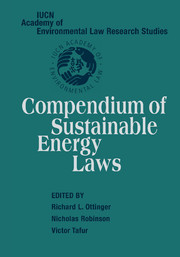Book contents
- Frontmatter
- Contents
- Acknowledgments
- Introduction
- I WORLD ENERGY ASSESSMENT
- World Energy Assessment: United Nations Development Programme, United Nations Department of Economics and Social Affairs, World Energy Council, World Energy Assessment and the Challenge of Sustainability (2000)
- II INTERNATIONAL AGREEMENTS
- III INTERNATIONAL LAW DECLARATIONS AND OTHER SOFT LAW INSTRUMENTS
- IV ACTION PLANS AND MULTILATERAL OPERATION RECOMMENDATIONS
- V SELECT REGIONAL INTERNATIONAL ENERGY AGREEMENTS
- VI SELECT NATIONAL LEGISLATION ILLUSTRATIVE OF SUSTAINABLE ENERGY LAW INNOVATIONS
- Index
- References
World Energy Assessment: United Nations Development Programme, United Nations Department of Economics and Social Affairs, World Energy Council, World Energy Assessment and the Challenge of Sustainability (2000)
Published online by Cambridge University Press: 03 May 2010
- Frontmatter
- Contents
- Acknowledgments
- Introduction
- I WORLD ENERGY ASSESSMENT
- World Energy Assessment: United Nations Development Programme, United Nations Department of Economics and Social Affairs, World Energy Council, World Energy Assessment and the Challenge of Sustainability (2000)
- II INTERNATIONAL AGREEMENTS
- III INTERNATIONAL LAW DECLARATIONS AND OTHER SOFT LAW INSTRUMENTS
- IV ACTION PLANS AND MULTILATERAL OPERATION RECOMMENDATIONS
- V SELECT REGIONAL INTERNATIONAL ENERGY AGREEMENTS
- VI SELECT NATIONAL LEGISLATION ILLUSTRATIVE OF SUSTAINABLE ENERGY LAW INNOVATIONS
- Index
- References
Summary
One way of looking at human development is in terms of the choices and opportunities available to individuals. Energy can dramatically widen these choices. Simply harnessing oxen, for example, multiplied the power available to a human being by a factor of 10. The invention of the vertical waterwheel increased productivity by another factor of 6; the steam engine increased it by yet another order of magnitude. The use of motor vehicles greatly reduced journey times and expanded human ability to transport goods to markets.
Today the ready availability of plentiful, affordable energy allows many people to enjoy unprecedented comfort, mobility, and productivity. In industrialised countries people use more than 100 times as much energy, on a per capita basis, as humans did before they learned to exploit the energy potential of fire.
Although energy fuels economic growth, and is therefore a key concern for all countries, access to and use of energy vary widely among them, as well as between the rich and poor within each country. In fact, 2 billion people – one-third of the world's population – rely almost completely on traditional energy sources and so are not able to take advantage of the opportunities made possible by modern forms of energy (World Bank, 1996; WEC-FAO, 1999; UNDP, 1997). Moreover, most current energy generation and use are accompanied by environmental impacts at local, regional, and global levels that threaten human well-being now and well into the future.
- Type
- Chapter
- Information
- Compendium of Sustainable Energy Laws , pp. 1 - 30Publisher: Cambridge University PressPrint publication year: 2005
References
- 3
- Cited by



